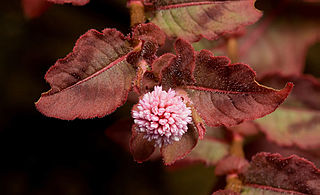
Persicaria is a genus of herbaceous flowering plants in the knotweed family, Polygonaceae. Plants of the genus are known commonly as knotweeds or smartweeds. It has a cosmopolitan distribution, with species occurring nearly worldwide. The genus was segregated from Polygonum.

Persicaria odorata, with common names Vietnamese coriander, rau răm, laksa leaf, Vietnamese cilantro, phak phai, praew leaf, hot mint, Cambodian mint and Vietnamese mint, is a herb whose leaves are used in Southeast Asian and Northeast Indian cooking.

Polygonum is a genus of about 130 species of flowering plants in the buckwheat and knotweed family Polygonaceae. Common names include knotweed and knotgrass. In the Middle English glossary of herbs Alphita, it was known as ars-smerte. There have been various opinions about how broadly the genus should be defined. For example, buckwheat has sometimes been included in the genus as Polygonum fagopyrum. Former genera such as Polygonella have been subsumed into Polygonum; other genera have been split off.

Persicaria maculosa is an annual plant in the buckwheat family, Polygonaceae. Common names include lady's thumb, spotted lady's thumb, Jesusplant, and redshank. It is widespread across Eurasia from Iceland south to Portugal and east to Japan. It is also present as an introduced and invasive species in North America, where it was first noted in the Great Lakes region in 1843 and has now spread through most of the continent.
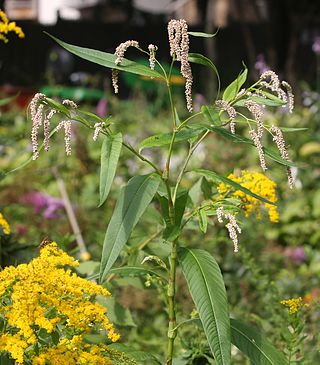
Persicaria lapathifolia, known as pale persicaria, is a plant of the family Polygonaceae. It is closely related to Persicaria maculosa and as such is considered a weed in Britain and Europe. Other common names for the plant include pale smartweed, curlytop knotweed, and willow weed. It is a species complex made up of a great many varying forms, sometimes considered varieties. The environment also has a strong influence on the morphology of an individual plant.

Persicaria hydropiper, also known as water pepper, marshpepper knotweed, arse smart or tade, is a plant of the family Polygonaceae. A widespread species, Persicaria hydropiper is found in Australia, New Zealand, temperate Asia, Europe and North America. The plant grows in damp places and shallow water. Cultivated varieties are eaten in East Asia for their pungent flavor.

Banksia attenuata, commonly known as the candlestick banksia, slender banksia, or biara to the Noongar people, is a species of plant in the family Proteaceae. Commonly a tree, it reaches 10 m (33 ft) high, but it is often a shrub in drier areas 0.4 to 2 m high. It has long, narrow, serrated leaves and bright yellow inflorescences, or flower spikes, held above the foliage, which appear in spring and summer. The flower spikes age to grey and swell with the development of the woody follicles. The candlestick banksia is found across much of the southwest of Western Australia, from north of Kalbarri National Park down to Cape Leeuwin and across to Fitzgerald River National Park.
In biological nomenclature, a nomen novum, new replacement name is a scientific name that is created specifically to replace another scientific name, but only when this other name cannot be used for technical, nomenclatural reasons. It does not apply when a name is changed for taxonomic reasons. It is frequently abbreviated, e.g.nomen nov., nom. nov..

Persicaria capitata, the pink-headed persicaria, pinkhead smartweed, pink knotweed, Japanese knotweed, or pink bubble persicaria, is an Asian species of plants in the genus Persicaria within the buckwheat family. It is native to Asia and grown as an ornamental in other countries. It has become naturalized in Australia, South Africa and a few scattered locations in the Americas.

Persicaria chinensis, commonly known as creeping smartweed or Chinese knotweed, is a plant species from the family Polygonaceae. It is widespread across China, Japan, the Indian Subcontinent, Indonesia, Malaysia, and Vietnam. It is a common plant in Malaysia and Vietnam, where it is used in herbal remedies, such as for the treatment of dysentery, enteritis, and sore throat. It is a weed in some coastal areas of New South Wales and Queensland in Australia.
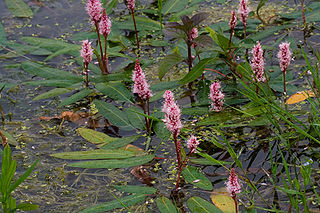
Persicaria amphibia is a species of flowering plant in the knotweed family known by several common names, including longroot smartweed, water knotweed, water smartweed, and amphibious bistort. It is native to much of North America, Asia, Europe, and parts of Africa, and it grows elsewhere as an introduced species and sometimes a noxious weed.
Metisella meninx, the marsh sylph, is a butterfly of the family Hesperiidae. It is endemic to the wet vleis of highland grassland in northern KwaZulu-Natal, Mpumalanga, Gauteng, the northern part of the Free State and the extreme east of the North West Province. It has become extinct in many areas close to Johannesburg due to building developments.

Acraea rahira, the marsh acraea, is a butterfly of the family Nymphalidae. It is found in southern Africa. In South Africa it is found from the Western Cape along the coast to the Eastern Cape and KwaZulu-Natal, then inland to Mpumalanga, Gauteng, Limpopo and North West.
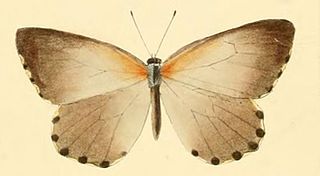
Mylothris bernice is a butterfly in the family Pieridae. It is found from Cameroon and Gabon to the Democratic Republic of the Congo, Rwanda, Burundi, Uganda and Zambia. The habitat consists of marshes and swamps.
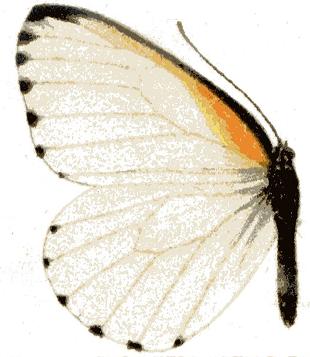
Mylothris rubricosta, the eastern swamp dotted border or streaked dotted border, is a butterfly in the family Pieridae. It is found in Sudan, Ethiopia, Uganda, Rwanda, Burundi, the Democratic Republic of the Congo, Kenya, Tanzania, Malawi, Zambia, Mozambique, Botswana and Zimbabwe. The habitat consists of papyrus swamps.

Persicaria decipiens, commonly known as slender knotweed, is a species of flowering plant native to Australia and Asia.
Persicaria dichotoma is a species of flowering plant native to Australia and Asia.
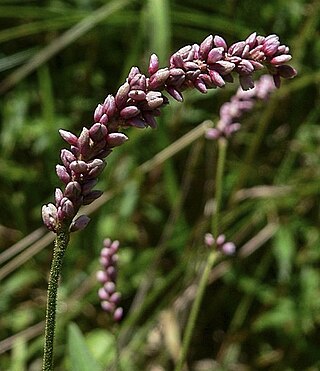
Persicaria elatior, commonly known as tall knotweed, is a species of flowering plant native to eastern Australia. It was one of eleven species selected for the Save a Species Walk campaign in April 2016; scientists walked 300 km to raise money for collection of seeds to be prepared and stored at the Australian PlantBank at the Australian Botanic Garden, Mount Annan.

Persicaria orientalis is a species of flowering plant in the family Polygonaceae, known as kiss-me-over-the-garden-gate and princess-feather. It was first described, as Polygonum orientale, by Carl Linnaeus in 1753. It was transferred to the genus Persicaria by Édouard Spach in 1841. Its native distribution is unclear. As of April 2023, Kew’s Plants of The World Online lists it’s native distribution as ranging from the Russian far east to Indochina, Malesia and Australia. It is widely cultivated and naturalized.

Persicaria prostrata, basionym Polygonum prostratum, is a species of flowering plant in the family Polygonaceae, native to Australia and perhaps New Zealand. It is known by the common name of creeping knotweed.















